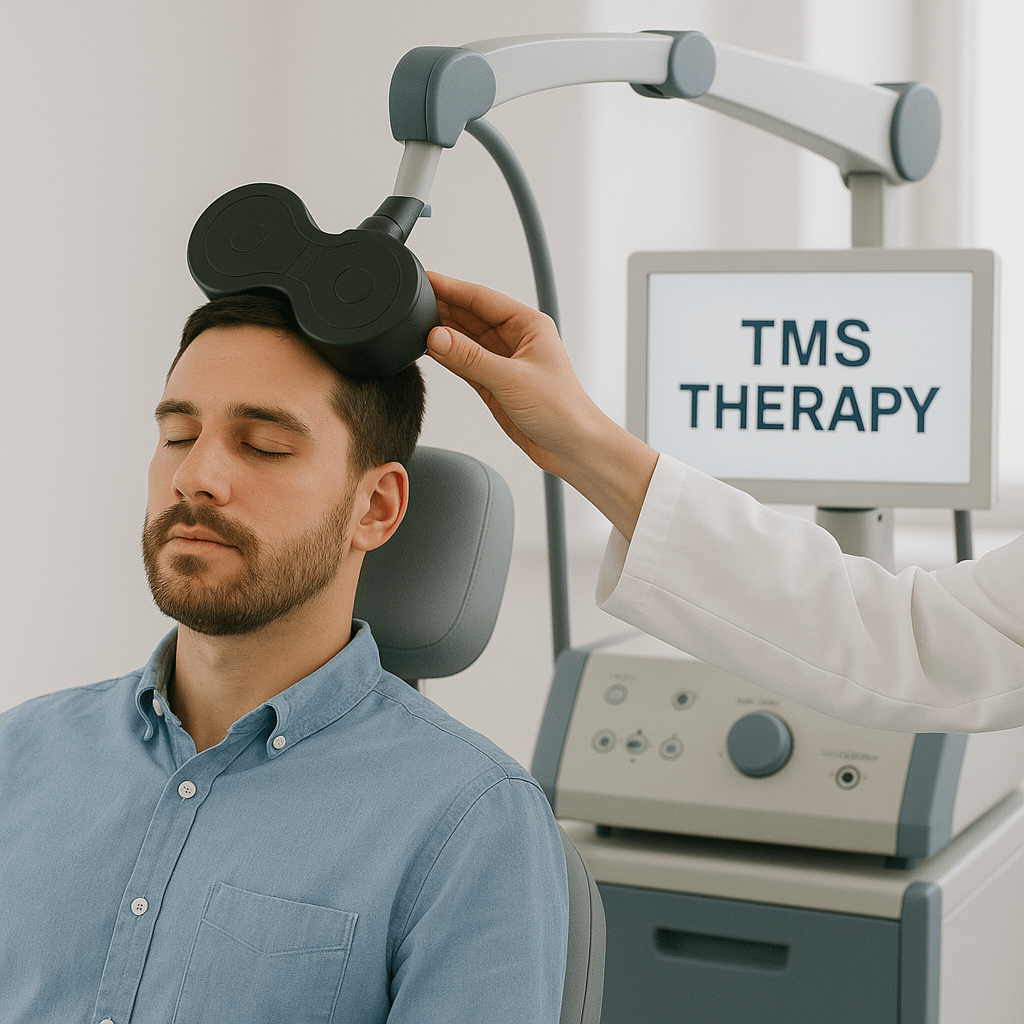TMS therapy, short for Transcranial Magnetic Stimulation therapy, is revolutionizing the way we treat mental health conditions. It’s a non-invasive technique that uses magnetic fields to stimulate specific parts of the brain. Unlike medications, TMS therapy doesn’t flood your system with chemicals; instead, it reactivates the brain’s natural pathways.
Since its approval by the U.S. FDA in 2008 for treatment-resistant depression, TMS therapy has grown rapidly in popularity. With more people seeking holistic and drug-free options, this therapy has become a game-changer in modern psychiatry.

How TMS Therapy Works on the Brain
TMS therapy operates through electromagnetic coils placed near the forehead. These coils deliver gentle pulses that penetrate the skull and activate underperforming areas of the brain, often related to mood and emotion regulation.
This stimulation enhances neural communication, encourages the production of mood-related neurotransmitters like serotonin, and gradually corrects brain circuit imbalances. It’s a direct, brain-centered approach without the need for surgery or medication.
The Growing Popularity of TMS Therapy
Why has TMS therapy become such a buzzword in mental health care? The answer lies in its effectiveness, safety, and minimal side effects. More than 5 million TMS sessions have been delivered globally, with high success rates.
Patients who previously struggled with chronic depression or anxiety have found renewed energy, better sleep, and clearer thinking. As media and celebrities highlight its benefits, public awareness has skyrocketed, making TMS therapy more mainstream than ever before.
TMS Therapy for Depression and Beyond
TMS for Depression and More
While it was initially designed for Major Depressive Disorder (MDD), the scope of TMS therapy now extends far beyond that. It is currently being used to treat:
- Obsessive-Compulsive Disorder (OCD)
- Post-Traumatic Stress Disorder (PTSD)
- Bipolar depression (with caution)
- Generalized Anxiety Disorder (GAD)
- Chronic pain conditions
- Addiction and smoking cessation
These breakthroughs are giving hope to people who’ve long felt stuck in a loop of unsuccessful treatments.
Is TMS Therapy Better Than Medication?
Medications like antidepressants or anti-anxiety drugs can be effective, but they often come with heavy baggage—weight gain, sleep issues, sexual dysfunction, and dependency risks. For patients who don’t respond or can’t tolerate these side effects, TMS therapy offers a clean alternative.
Unlike pills that affect the entire body, TMS therapy targets specific brain regions. It offers a precision treatment model with fewer side effects and no long-term dependency.
Who Should Consider TMS solution?
TMS therapy is not for everyone, but many people qualify. Ideal candidates are:
- Adults (18+) with moderate to severe depression
- People who have tried at least one antidepressant with little success
- Individuals sensitive to medication side effects
- Patients without a history of seizures or metal implants in the skull
Proper screening and consultation with a psychiatrist are crucial before starting.
What to Expect During a TMS Session?
Each session is relatively quick and comfortable:
- Preparation: You’re seated in a reclining chair with a head support.
- Coil Placement: A technician places the coil near your scalp.
- Stimulation: Gentle tapping or clicking sounds occur as magnetic pulses are delivered.
- Duration: Sessions last about 20–40 minutes, 5 times a week, for 4–6 weeks.
There’s no recovery time—you can drive home or return to work right after.
Side Effects and Safety of TMS Treatment
TMS therapy is widely regarded as safe. The most commonly reported side effects include:
- Mild headache or scalp discomfort
- Temporary dizziness
- Facial twitching during treatment
Serious complications, like seizures, are infrequent and occur in less than 0.1% of cases. Thanks to FDA approval and strict protocols, most patients complete their treatment with little to no disruption in daily life.
Real-Life Benefits of TMS Therapy
The success stories are powerful. Patients often report:
- Feeling emotionally lighter
- Improved concentration
- Better quality sleep
- Enhanced social engagement
- Reduced cravings (especially in addiction therapy)
What makes TMS therapy so promising is its potential to change lives, not just manage symptoms, but transform outlooks.
The Cost and Insurance Coverage of TMS Application
TMS therapy can be costly without coverage. A full course may cost between $6,000 to $12,000. However, the good news is that many major insurers now cover it:
- Medicare & Medicaid
- Blue Cross Blue Shield
- UnitedHealthcare
- Aetna
Patients must demonstrate treatment resistance with documentation. Clinics often help with insurance pre-approval and financing plans.
TMS Therapy for Teens and Young Adults
Research into TMS therapy for adolescents is ongoing, with early results showing promise. While it’s not yet universally approved for minors, some specialized clinics offer it off-label for teens with severe depression or anxiety.
Safety in this group appears strong, though more data is needed. Parents considering TMS for their children should consult with experienced pediatric psychiatrists.
Myths and Misunderstandings About TMS Therapy
Let’s bust some myths:
- Myth: It’s like shock therapy.
Truth: TMS doesn’t use electricity. It’s painless and non-invasive. - Myth: You need it forever.
Truth: Most patients see results in 4–6 weeks, though boosters may be needed. - Myth: It changes your personality.
Truth: It helps restore your brain’s natural rhythm without altering who you are.
The Future of TMS Therapy in Mental Health
The future of TMS treatment looks exciting. Innovations on the horizon include:
- Deep TMS: Reaching further brain structures
- Wearable TMS: For at-home use
- AI-guided treatment plans: Optimizing brain maps and pulse frequency
- TMS combined with therapy and mindfulness apps
As research expands, so will the range of conditions it can treat—from eating disorders to Alzheimer’s.
Frequently Asked Questions About TMS Therapy
1. How soon will I feel results from TMS therapy?
Most patients notice improvements within 2–4 weeks, though full benefits usually take 6 weeks.
2. Can I continue my meds during TMS?
Yes, many do. However, consult your doctor for proper adjustments.
3. Is TMS covered by my insurance?
If you meet the criteria, many providers do offer coverage.
4. Are there any long-term side effects?
No known long-term side effects. Most discomfort is temporary and mild.
5. Can I drive after TMS sessions?
Absolutely. There’s no sedation or downtime involved.
6. How long do the effects of TMS last?
Benefits can last months to years. Some patients return for maintenance sessions.
Conclusion: Is TMS Therapy the Right Choice?
TMS therapy is more than just a buzzword; it’s a breakthrough. For those who have struggled with depression, anxiety, or OCD, it opens a door to hope, healing, and a better quality of life.
With minimal side effects, growing research support, and increasing insurance coverage, TMS therapy is paving the way toward a future where mental health treatment is more precise, personal, and effective than ever.
